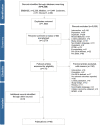Automation of in-hospital pharmacy dispensing: a systematic review
- PMID: 32434785
- PMCID: PMC7907692
- DOI: 10.1136/ejhpharm-2019-002081
Automation of in-hospital pharmacy dispensing: a systematic review
Abstract
Objectives: The current systematic review (SR) was undertaken to identify and summarise the published literature reporting on the clinical and economic value of automated in-hospital pharmacy services with a primary focus on systems supporting the dispensing of medicines.
Methods: Literature searches were conducted in MEDLINE, Embase and the Cochrane Library on 17 December 2017 to identify English-language publications investigating any automated dispensing systems (ADSs) in the inpatient setting to include central pharmacy and ward-based systems.
Results: 4320 publications were screened by title and abstract and 45 of 175 full publications screened were included. Grey literature searching identified an additional three publications. Therefore, 48 publications relating to ADSs were eligible for inclusion. Although a relatively large evidence base was identified as part of the current SR, the eligible studies were inconsistent in terms of their design and the format of reporting of outcomes. The studies demonstrate that both pharmacy and ward-based ADSs offer benefits over traditional manual dispensing methods in terms of clinical and economic outcomes. The primary benefits following implementation of an ADS include reductions in medication errors, medication administration time and costs. Studies examining optimisation/inventory management strategies/refill programmes for these systems suggest that optimal implementation of the ADS is required to ensure that clinical success and economic benefits are maximised.
Conclusions: The published evidence suggests positive impacts of ADS and should encourage hospitals to invest in automation, with a global strategy to improve the reliability and the efficiency of the medication process. However, one of the key findings of the current SR is the need for further data from adequately powered studies reporting clinically relevant outcomes which would allow for robust, evidence-based recommendations on the return on investment of the technologies. These studies would probably contribute to a larger adoption of these technologies by European hospitals.
Keywords: clinical pharmacy; dispensing forms; dispensing robots; hospital pharmacy automation; uni dose system.
© European Association of Hospital Pharmacists 2021. No commercial re-use. See rights and permissions. Published by BMJ.
Conflict of interest statement
Competing interests: PB and AH report personal fees from Becton Dickinson, outside the submitted work. SB and SAM of Mtech Access were paid consultants to BD.
Figures
References
Publication types
MeSH terms
LinkOut - more resources
Full Text Sources
Research Materials
Miscellaneous

